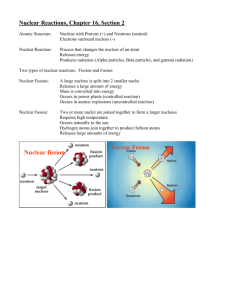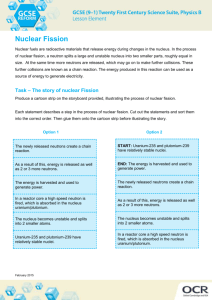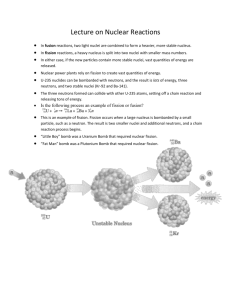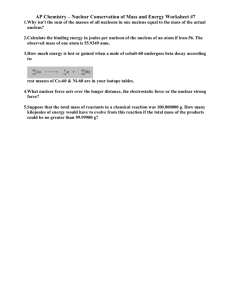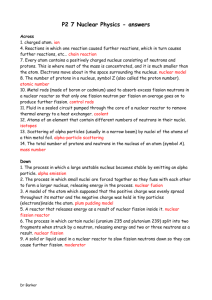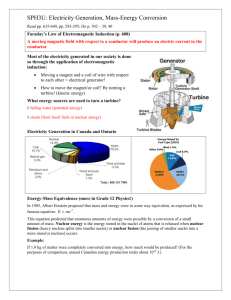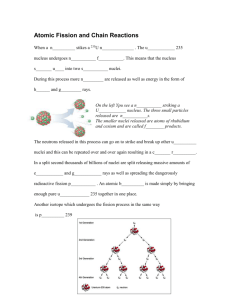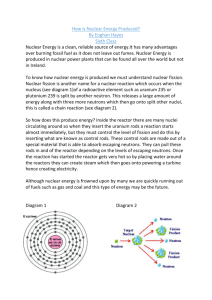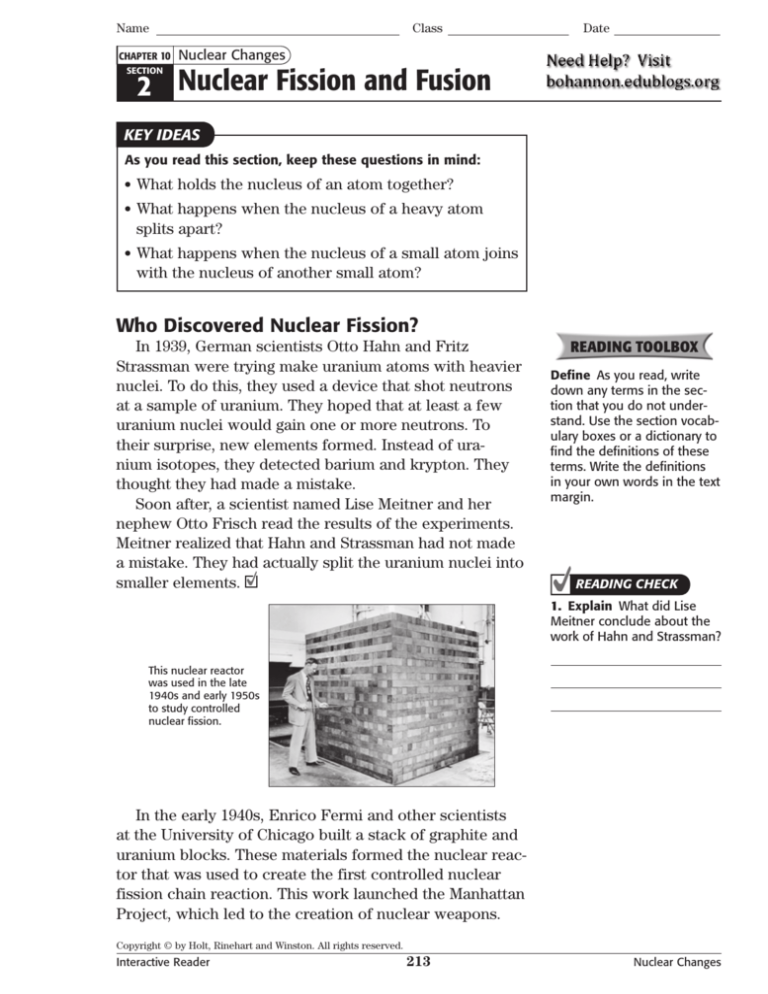
Name
CHAPTER 10
Class
Date
Nuclear Changes
SECTION
21 Nuclear Fission and Fusion
KEY IDEAS
As you read this section, keep these questions in mind:
• What holds the nucleus of an atom together?
• What happens when the nucleus of a heavy atom
splits apart?
• What happens when the nucleus of a small atom joins
with the nucleus of another small atom?
Who Discovered Nuclear Fission?
In 1939, German scientists Otto Hahn and Fritz
Strassman were trying make uranium atoms with heavier
nuclei. To do this, they used a device that shot neutrons
at a sample of uranium. They hoped that at least a few
uranium nuclei would gain one or more neutrons. To
their surprise, new elements formed. Instead of uranium isotopes, they detected barium and krypton. They
thought they had made a mistake.
Soon after, a scientist named Lise Meitner and her
nephew Otto Frisch read the results of the experiments.
Meitner realized that Hahn and Strassman had not made
a mistake. They had actually split the uranium nuclei into
smaller elements.
READING TOOLBOX
Define As you read, write
down any terms in the section that you do not understand. Use the section vocabulary boxes or a dictionary to
find the definitions of these
terms. Write the definitions
in your own words in the text
margin.
READING CHECK
1. Explain What did Lise
Meitner conclude about the
work of Hahn and Strassman?
This nuclear reactor
was used in the late
1940s and early 1950s
to study controlled
nuclear fission.
In the early 1940s, Enrico Fermi and other scientists
at the University of Chicago built a stack of graphite and
uranium blocks. These materials formed the nuclear reactor that was used to create the first controlled nuclear
fission chain reaction. This work launched the Manhattan
Project, which led to the creation of nuclear weapons.
Copyright © by Holt, Rinehart and Winston. All rights reserved.
Interactive Reader
213
Nuclear Changes
Name
SECTION 2
Class
Date
Nuclear Fission and Fusion continued
What Holds a Nucleus Together?
Protons and neutrons are packed tightly in the tiny
nucleus of an atom. Recall that some atomic nuclei are
unstable and emit nuclear radiation as they decay. The
stability of a nucleus depends on the nuclear forces
that hold the nucleus together. If like charges repel one
another, how can positively charged protons fit together
into an atomic nucleus without flying apart?
THE STRONG NUCLEAR FORCE
READING CHECK
The strong nuclear force holds the neutrons and
protons together in a nucleus. This attraction is much
stronger than the electric force that causes protons
to repel other protons. However, the attraction only
happens over a very short distance (3 × 10–15 meters).
This is less than the width of three protons.
2. Compare Compare the
relative strengths of the
nuclear force and the electric
force.
4USPOHOVDMFBSGPSDF
BDUTPOQSPUPOTBOEOFVUSPOT
&MFDUSJDSFQVMTJPO
BDUTPOQSPUPOT
The strong nuclear force that holds protons and neutrons together is stronger than
the electrical force that pushes protons apart.
THE STRONG NUCLEAR FORCE AND STABILITY
READING CHECK
3. Describe What are
the relative strengths of
attractive and repulsive
forces in a stable nucleus?
Because neutrons have no charge, they do not attract
or repel protons or one another. However, protons repel
one another due to the electric force and attract one
another due to the nuclear force. In stable nuclei, the
attractive forces are stronger than the repulsive forces.
Under these conditions, the element does not undergo
decay.
Copyright © by Holt, Rinehart and Winston. All rights reserved.
Interactive Reader
214
Nuclear Changes
Name
Class
SECTION 2
Date
Nuclear Fission and Fusion continued
What Causes a Nucleus to Decay?
An element decays when the repulsive forces in the
nucleus are stronger than the attractive forces. A large
number of neutrons in an atom can help hold a nucleus
together. However, there is a limit to how many neutrons
a nucleus can have. Nuclei with too many or too few neutrons are unstable and undergo decay.
UNSTABLE NUCLEI
Nuclei with more than 83 protons are always unstable,
no matter how many neutrons they have. These nuclei
always decay and release large amounts of energy and
nuclear radiation. Some of the energy is passed to the
particles that leave the nucleus. The rest of the energy
leaves the nucleus in the form of gamma rays. This radioactive decay helps produce a more stable nucleus.
What Is Nuclear Fission?
The process of splitting atoms with heavy nuclei into
atoms with lighter nuclei is called fission. When the
nucleus splits, both neutrons and energy are released.
In their experiments, Hahn and Strassman used a
device that shot at, or bombarded, a uranium-235 nucleus
with neutrons. One set of products from this type of
fission includes two lighter nuclei, barium-140 and
krypton-93, and neutrons and energy.
235
92
93
1
U + 10 n 140
56 Ba + 36 Kr + 3 0 n + energy
Notice that the products include three neutrons
plus energy. Uranium-235 can also undergo fission to
produce different pairs of lighter nuclei. For example,
uranium-235 can undergo fission to produce strontium-90,
xenon-143, and three neutrons.
How Does Nuclear Fission Produce Energy?
During fission, the nucleus breaks into smaller nuclei.
The process releases large amounts of energy. Each dividing nucleus releases about 3.2 × 10–11 joules of energy. In
comparison, the chemical reaction of one molecule of the
explosive trinitrotoluene (TNT) releases 4.8 × 10–18 joules.
READING CHECK
4. Identify Under what
conditions does a nucleus
decay?
READING CHECK
5. Identify What is the
maximum number of protons
that can be found in a stable
nucleus?
EHHDBG@<EHL>K
6. Analyze How many total
neutrons are on the left side
of the equation? How many
total neutrons are found on
the right?
Math Skills
7. Compare How much
more energy is released by
a dividing nucleus than by a
molecule of TNT?
Copyright © by Holt, Rinehart and Winston. All rights reserved.
Interactive Reader
215
Nuclear Changes
Name
SECTION 2
Class
Date
Nuclear Fission and Fusion continued
When a uranium-235 nucleus is bombarded by a neutron, the nucleus breaks apart
into smaller nuclei. The process releases energy through fast moving neutrons.
READING CHECK
8. Explain Why is some
mass missing after fission?
READING CHECK
In their experiment, Hahn and Strassman recorded the
masses of all of the nuclei and particles before and after
the reaction. They found the overall mass had decreased
after the reaction. Hahn and Strassman also found that
the process had released energy. They concluded that the
missing mass must have changed into energy.
What Is Mass-Energy Equivalence?
Recall that, according to Newton’s laws, no mass or
energy can be created or destroyed during physical or
chemical changes. The laws of conservation of mass and
energy do not apply to nuclear reactions such as fission.
During fission, some matter changes to energy.
Albert Einstein explained the equivalence of mass and
energy by the special theory of relativity. This equivalence
means that matter can be converted into energy, and
energy can be converted into matter. Equivalence is
described by the equation below.
9. Explain What does massenergy equivalence mean?
Mass-Energy Equation
Energy = mass × (speed of light)2
E = mc2
The speed of light, c, equals 3.0 × 108 m/s. If you multiply c 2 by even a very small mass, the energy value is very
large. For example, the mass-equivalent energy of 1 kg of
matter is 9 × 1016 joules. That is more than the energy of
22 million tons of the explosive TNT.
Copyright © by Holt, Rinehart and Winston. All rights reserved.
Interactive Reader
216
Nuclear Changes
Name
SECTION 2
Class
Date
Nuclear Fission and Fusion continued
STABILITY OF MATTER
Obviously, the objects around us do not change suddenly into their equivalent energies. The results of that
would be disastrous. Under ordinary conditions, matter is
very stable.
What Is the Mass Defect?
Suppose you measured the mass of a carbon-14
nucleus, which has six protons and eight neutrons.
Suppose you then measured the mass of six individual
protons and eight individual neutrons. You would expect
the mass of the nucleus to be the same as the total mass
of the individual particles. However, you find that the
mass of the nucleus is less than the sum of the individual
masses. What happened to the missing mass?
Mass of 1 proton
= 1.673 × 10−27 kg
Mass of 6 protons
=
Mass of 1 neutron
= 1.675 × 10−27 kg
Mass of 8 neutrons
=
Actual mass of a carbon-14 nucleus
= 2.325 × 10−26 kg
Expected mass of a carbon-14 nucleus
=
The missing mass is called the mass defect. Einstein’s
theory of special relativity explains: the missing mass
changes into energy. When nuclei form, energy is
released. Note, however, that the mass defect of a
nucleus is very small.
What Is a Nuclear Chain Reaction?
Math Skills
10. Calculate Complete the
table to compare the expected and actual values for the
mass of a carbon-14 nucleus.
READING CHECK
11. Define What is the mass
defect?
Have you ever watched balls moving on a pool table?
When one ball hits another, the collision can cause the
second ball to hit another. Some nuclear reactions work
the same way. One reaction triggers another reaction.
A nucleus that splits when it is hit by a neutron forms
smaller nuclei. The smaller nuclei need fewer neutrons
to be held together. Therefore, they release extra neutrons. If one of those neutrons collides with another
large nucleus, that nucleus undergoes fission, or splits. A
nuclear chain reaction is a continuous series of nuclear
fission reactions.
Copyright © by Holt, Rinehart and Winston. All rights reserved.
Interactive Reader
217
Nuclear Changes
Name
SECTION 2
Class
Date
Nuclear Fission and Fusion continued
1
n
0
93
Kr
36
93
Kr
36
1
n
0
1
n
0
1
n
0
140
Ba
56
EHHDBG@<EHL>K
1
n
0
140
56 Ba
1
n
0
140
Ba
56
1
n
0
1
n
0
235
U
92
235
U
92
235
U
92
1
n
0
235
U
1
n 92
0
93
Kr
36
1
n
0
235
U
92
12. Predict How many total
neutrons will probably be
released in the next stage of
this chain reaction?
1
n
0
93
36 Kr
235
U
92
235
U
92
235
U
92
1
n
0
140
Ba
56
235
U
92
235
U
92
A nuclear chain reaction may be triggered, or started, by a single neutron.
Scientists found that on average, each uranium
nucleus that divides produces two or three extra neutrons. Each one of these neutrons could trigger, or start,
another fission reaction. The ability to start a nuclear
chain reaction depends partly on the number of neutrons
released during each fission reaction.
What Is a Controlled Chain Reaction?
Energy produced in a nuclear chain reaction can be
used to generate electricity. The diagram describes this
process.
This is how nuclear
Using Nuclear Chain Reactions to Generate Electricity
1
2
Uranium-235
nuclei in the
fuel rod (black)
undergo a chain
reaction. Control
rods (gray)
absorb neutrons.
This keeps the
chain reaction at
a safe level.
A coolant, usually
water, absorbs energy
from the chain reaction.
3
Water absorbs
energy from the hot
coolant and changes
to steam.
power is generated.
There has been
questions asking about
portions of this process
on the EOCT. Please
take a moment and
write down these 5
steps.
EHHDBG@<EHL>K
13. Identify What is the
function of the control rods?
To cooling
tower
5
4
The steam turns a turbine
attached to a generator.
The generator changes the
mechanical energy of the spinning
turbine into electrical energy.
Copyright © by Holt, Rinehart and Winston. All rights reserved.
Interactive Reader
218
Nuclear Changes
Name
Class
SECTION 2
Date
Nuclear Fission and Fusion continued
NUCLEAR WEAPONS
The chain-reaction principle is also used to make a
nuclear bomb. In a nuclear bomb, two or more quantities
of uranium-235 are packed into a container. The uranium
is surrounded by a powerful chemical explosive. When
the explosives are detonated, or set off, the uranium is
pushed together to exceed the critical mass. The critical
mass is the smallest amount of a substance that provides
enough neutrons to start a nuclear chain reaction.
If the amount of a substance is less than the critical
mass, a chain reaction will not continue. Fortunately, the
concentration of uranium-235 in nature is too low to start
a chain reaction naturally. In nuclear power plants, control rods are used to slow the chain reaction. In a nuclear
bomb, reactions are not controlled.
READING CHECK
14. Define What is a
critical mass?
What Is Nuclear Fusion?
Nuclear fission is not the only nuclear process that can
produce energy. Energy can also be produced when light
atomic nuclei join, or fuse, to form heavier nuclei. This
process is called fusion.
In the sun and other stars, huge amounts of energy are
produced when hydrogen nuclei fuse. However, a large
amount of energy is needed to start a fusion reaction.
Energy is needed to push nuclei close enough so that the
strong nuclear force can overcome the repulsive electrical force. In stars, extremely high temperatures provide
the energy to bring hydrogen nuclei together.
1
H
1
+ 11H → 21 H + other particles
2
H + 11H → 32He + 00γ
1
3FBDUJPO
3
He
2
READING CHECK
15. Describe What happens
during nuclear fusion?
This information
typically finds its way
onto the EOCT or my
test. Make sure it is in
your notes.
+ 32He → 42He + 11H + 11H
3FBDUJPO
3FBDUJPO
3FBDUJPO
3FBDUJPO
The process of nuclear fusion releases large amounts of energy.
Copyright © by Holt, Rinehart and Winston. All rights reserved.
Interactive Reader
219
Nuclear Changes
Name
Class
Date
Section 2 Review
SECTION VOCABULARY
critical mass the minimum mass of a
fissionable isotope that provides the number
of neutrons needed to sustain a chain reaction
fission the process by which a nucleus splits
into two or more fragments and releases
neutrons and energy
fusion the process in which light nuclei
combine at extremely high temperatures,
forming heavier nuclei and releasing energy
nuclear chain reaction a continuous series of
nuclear fission reactions
1. Summarize Complete the process chart to describe how nuclear fission is used to
produce electricity.
A coolant absorbs energy from the chain reaction.
A generator changes the mechanical energy of the spinning turbine into electrical energy.
2. Predict Suppose you had an atom of
56
26
Fe. Is the mass of its nucleus greater
than, less than, or equal to the combined masses of 26 protons and 30 neutrons?
Explain your answer.
3. Identify Do the following equations describe nuclear fission or nuclear fusion?
Explain your answers.
235
1
140
93
1
92 U + 0 n 56 Ba + 36 Kr + 3 0 n + energy
208
82
Pb +
58
26
1
Fe 265
108 Hs + 0 n
Copyright © by Holt, Rinehart and Winston. All rights reserved.
Interactive Reader
220
Nuclear Changes

